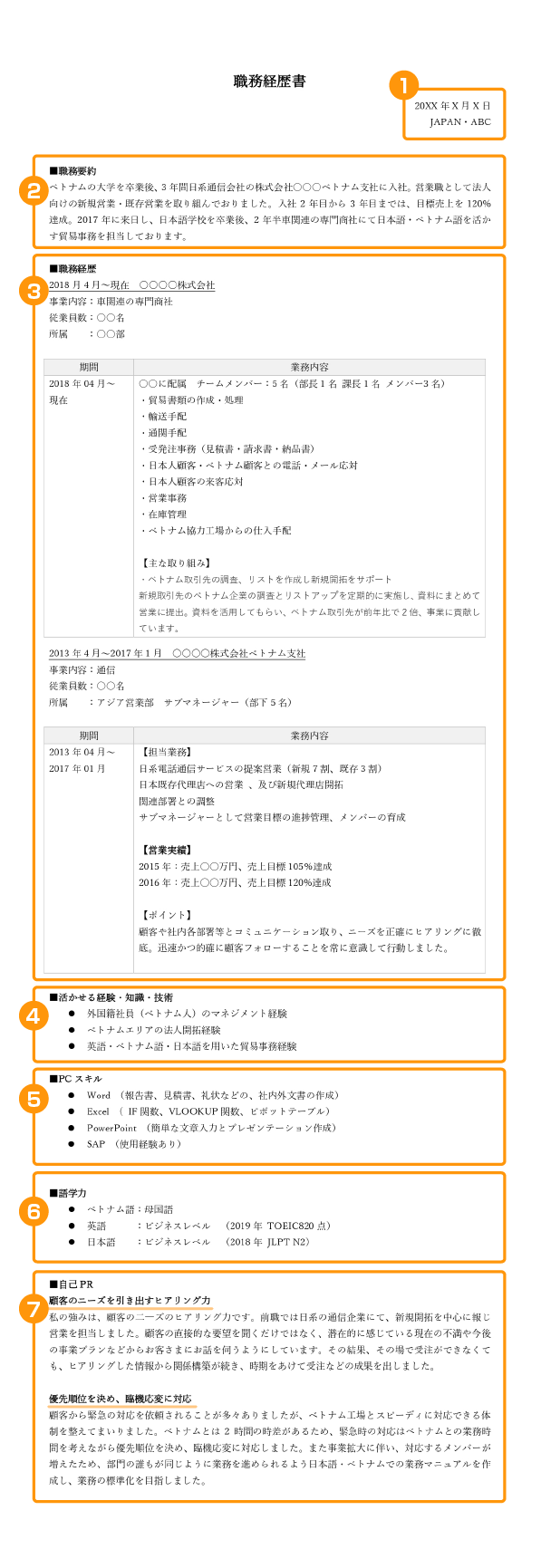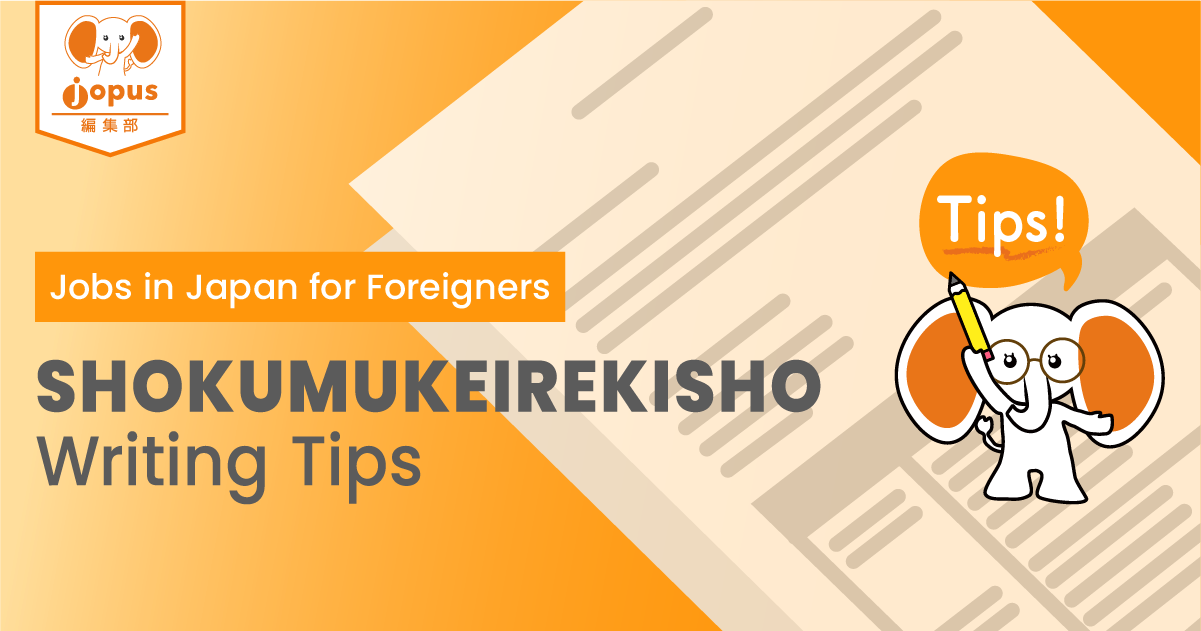Used in the career transition process, the shokumukeirekisho(職務経歴書) is an application document that holds equal importance to the rirekisho. While details of work experience are not listed on a rirekisho, applicants specify their past job responsibilities, skills, and experiences on a shokumukeirekisho.As a result, recruitment staff read the shokumukeirekisho to measure how applicants can potentially utilize their skills and experiences towards the job they are applying for. Below, we explain the correct way to fill out a shokumukeirekisho and provide tips to raise one’s chances of passing an application screening process.
- How to fill out a shokumukeirekisho
- Date/Name
- Career Summary
- Work History
- Computer Skills
- Knowledge, Experiences, and Skills
- Language Proficiency Levels
- Self-PR
- Three points to keep in mind when writing a shokumukeirekisho
- Be careful of Japanese typos
- Keep formatting consistent
- Omit irrelevant information
- Summary
How to fill out a shokumukeirekisho
First, we will discuss how to write a shokumukeirekisho using a standard template (shown below).

① Date/Name
Write the date and your name in the upper righthand corner of the document. The date should be the day you submit the document. Your name can be typed in English (as opposed to katakana).
② Career Summary
Write a summary of your work history, including information on what types of companies and departments you worked for and what job titles or responsibilities you held. This section should be about 200-250 characters.
③ Work History
Create a subsection for each company at which you were employed and write about your job roles and responsibilities. The order of companies should be chronological, beginning with the most recent company you worked for.
【Employment period】Write the period in which you were employed at the company using years and months.
【Company name】If the company is a foreign one, type its name in English (as opposed to katakana).
【Company description】Provide a brief description of basic company information.
【Number of employees】Write down the number of employees at the company to show the scale of its business.
【Department and Position】If applicable, also mention the number of subordinates you oversaw.
【Job description】
Job responsibilities
Summarize what you did and for whom. To summarize in an easy-to-follow manner, it may be a good idea to reference job postings of similar positions on job-search websites.
Management experience
If you have management experience, mention it in your job description.
Accomplishments
Supply information on your sales performance and your contributions to the company. If you have a history of promotion, write this down as well.
④ Knowledge, Skills, and Experiences
List past experiences and skills that you can bring to the job.
⑤ Computer Skills
Mention your skill level for each software program you can use. Companies often seek out Excel skills, so we recommend specifying your skill level and the tasks you can conduct in Excel.
【日本語の例】
初級:Excel(四則演算・票作成・基本的な関数)
中級:Excel(ピポットテーブル、VLOOKUP、IF関数、グラフ作成)
上級:Excel(データベース作成、マクロ機能、VBA)
⑥ Language Proficiency Levels
List languages you can use in the workplace, explaining your proficiency in each using the following three categories: (1) native level, (2) business level, and (3) daily conversation level.
If you are not from an English-speaking country, write down your TOEIC and/or IELTS score. Furthermore, providing your JLPT level (e.g. N1, N2, etc.) will help recruitment staff more easily predict your Japanese language level.
⑦ Self-PR
Write about experiences and/or knowledge you have gained, especially those that pertain to experiences or track records that the company is looking for in candidates. The word count should be about 100-200 characters. If you would like to call attention to multiple points, split them into separate paragraphs or subsections.
Three points to keep in mind when writing a shokumukeirekisho
1. Be careful of Japanese typos
If there is a sizable number of Japanese typos (e.g. using incorrect kanji or dropping characters), recruitment staff will likely think that your Japanese language level is low. Moreover, multiple typos on a shokumukeirekisho will hurt the evaluation of candidates applying to jobs that require attention to detail (i.e. administrative/clerical work or accounting). For these reasons, be sure to reread your document for typos before submitting it.
2. Keep formatting consistent
Documents that are not consistent in font type and size are difficult to read. Additionally, applicants may be judged to have a low ability to produce paperwork if they submit documents that are not uniform in appearance. Therefore, it is best to keep font types, sizes, and colors consistent.
*Note: It is okay to change font sizes and colors in some cases if your goal is to call attention to a certain point or area.
3. Omit irrelevant information
The shokumukeirekisho serves as a document that succinctly conveys one’s skills and experiences. As a result, including large amounts of irrelevant information will make it difficult to communicate important points to recruitment staff. It may not be within one’s best interest to include part-time jobs or volunteer activities from university years if those experiences cannot be utilized in the job that is being applied for. Hobbies and talents are not relevant to job responsibilities and are thus not necessary for the shokumukeirekisho. If you would like to mention hobbies and talents, include them in your rirekisho.
Summary
In this article, we introduced how to write a shokumukeirekisho, which is a document particular to Japan. CVs abroad often follow a loose structure, but as shown above, Japanese documents often adhere to a strict format. As the purpose of the shokumukeirekisho is to highlight your skills and experiences, be careful not to overlook any relevant experiences gained through past jobs. Finally, for those who are concerned with their Japanese language ability, ask a friend or recruiting agent to help edit and proofread your documents.
List of ways to look for jobs in Japan
- Recruitment Agency for Expats in Japan
- Job Board for Expats in Japan
- Search for jobs by occupation in Japan
- Search for jobs by industry in Japan
Job Hunting Guide for International Students














